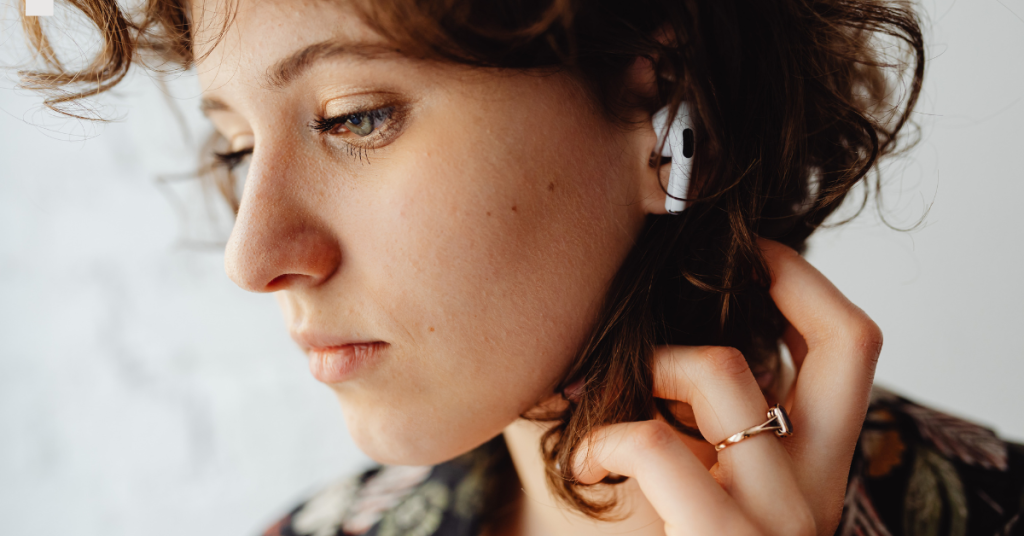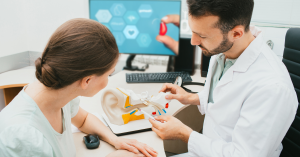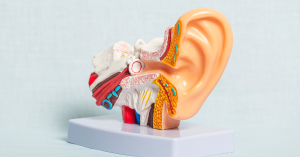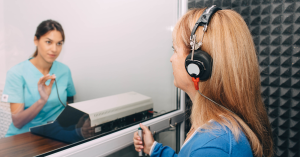Earbuds have become an everyday accessory for millions of people—used during workouts, commutes, workdays, and even bedtime. Their convenience, portability, and improving sound quality have made them the go-to choice for listening to music, podcasts, phone calls, and more. But as earbuds become increasingly embedded in our daily routines, so too does the concern about their potential impact on our hearing.
Unlike traditional over-ear headphones, earbuds sit directly inside the ear canal, placing the sound source just millimeters from the delicate structures of the inner ear. This close proximity, combined with frequent long-term use and high volume levels, may significantly raise the risk of noise-induced hearing loss. For older adults or anyone already experiencing hearing challenges, this risk can be even more serious.
In this article, we’ll explore the connection between earbuds and hearing loss risk—how they work, what science says about their effects, the warning signs of damage, and practical steps you can take to protect your hearing. Whether you’re a lifelong earbud user or just starting to notice the effects of too much noise, this guide will help you make safer, more informed choices for your auditory health.
How Earbuds Work and Why It Matters
To understand the potential hearing risks of earbuds, it helps to first understand how they work. Earbuds are small speakers that fit snugly inside the outer ear canal. Unlike over-ear headphones, which sit on or around the ears, earbuds channel sound directly into the ear, reducing the distance between the sound source and your eardrum. This means sound waves from earbuds hit the sensitive structures of your inner ear more directly and, in many cases, more intensely.
The closer placement creates a more immersive audio experience, but it also increases the potential for damage—especially when the volume is turned up too high. When you use earbuds in noisy environments, like public transit or crowded streets, you’re more likely to raise the volume to drown out background noise. Unfortunately, this habit can push sound levels into ranges that are harmful to hearing, often without you realizing it.
There’s also a difference in sound isolation. Earbuds typically offer less passive noise blocking than over-ear headphones. Some modern earbuds include active noise cancellation (ANC), which can help reduce the need for higher volume levels. However, many people still rely on non-ANC earbuds or use them inappropriately, turning up the sound to unsafe levels in order to hear clearly.
Compared to over-ear headphones, which distribute sound around the ear and have more space between the speakers and your eardrums, earbuds deliver a more concentrated dose of sound in a smaller area. Over time, this can contribute to cumulative damage, especially with prolonged listening sessions.
In short, the way earbuds are designed and used puts users at greater risk of developing noise-related hearing problems. The risk isn’t just about the device—it’s also about how often you use it, how loud the volume is, and whether you’re giving your ears time to recover. As we’ll explore next, that repeated exposure to loud sound can have real, lasting consequences for your hearing health.
The Science Behind Noise-Induced Hearing Loss
Noise-induced hearing loss (NIHL) occurs when the delicate hair cells inside the cochlea—your inner ear’s sound-sensing organ—are damaged by excessive sound levels. These hair cells convert sound waves into electrical signals that your brain interprets as hearing. Once these cells are damaged or destroyed, they don’t regenerate, making the hearing loss permanent.
The risk of NIHL depends on two key factors: volume (measured in decibels, or dB) and duration of exposure. Sounds above 85 dB are considered potentially harmful if you’re exposed for extended periods. For context, normal conversation registers at about 60 dB, while many earbuds can reach volumes well over 100 dB when cranked to maximum—similar to the noise level at a rock concert or near a chainsaw. At that intensity, even 15 minutes of exposure can begin to cause damage.
What makes earbuds especially risky is how easily they can expose users to these unsafe levels. Unlike a loud environment where you might instinctively move away from the noise, earbuds deliver that sound directly into your ear without any distance buffer. And because hearing loss from noise exposure is usually painless and gradual, you may not realize it’s happening until noticeable symptoms emerge.
Another key factor is cumulative exposure. Even if you listen at moderate volumes, using earbuds for several hours a day over weeks, months, or years can still lead to long-term hearing degradation. This is especially concerning for those who wear earbuds during work, exercise, and relaxation—often logging hours of use daily.
Researchers have identified patterns showing that people who use personal audio devices at high volumes are more likely to develop signs of hearing loss earlier in life. Unfortunately, many of these individuals are unaware of the risk until they begin to experience problems like difficulty understanding speech, especially in noisy environments, or the onset of tinnitus (a persistent ringing or buzzing in the ears).
Understanding the science behind noise-induced hearing loss emphasizes the importance of volume control and listening habits. By being aware of how sound affects your ears, you can take proactive steps to avoid damage and preserve your hearing well into the future.
Signs Your Hearing Might Be Affected
One of the most challenging aspects of hearing loss is how subtle it can be in the early stages. Many people don’t realize their hearing is declining until it starts to impact daily life. When earbuds are part of your routine, recognizing the early warning signs of damage becomes even more important.
A common early symptom is difficulty understanding speech, particularly in noisy environments like restaurants or social gatherings. You might find yourself asking others to repeat themselves more often or feeling like people are mumbling. This occurs because high-frequency hearing—essential for distinguishing consonants like “s,” “f,” and “th”—is often the first to be affected by noise-related damage.
Another red flag is tinnitus, a condition characterized by ringing, buzzing, or hissing sounds in the ears when no external sound is present. While tinnitus can have many causes, it’s frequently a sign of damage to the auditory system, especially when it follows extended use of loud audio through earbuds.
You may also notice a sense of muffled hearing after a long listening session. While this temporary threshold shift might go away after a few hours, repeated incidents can lead to more permanent hearing loss over time.
Other signs to watch for include:
- Needing to increase the volume on the TV or phone higher than others prefer
- Struggling to follow conversations on the phone
- Feeling fatigued or mentally drained after trying to listen or participate in group conversations
- Becoming more socially withdrawn due to the frustration of not hearing clearly
These early indicators shouldn’t be ignored, especially if you’re a frequent earbud user. Catching hearing issues early can make a significant difference in managing or even preventing further damage.
If you’re experiencing any of these symptoms—especially in combination—it’s time to take a closer look at your listening habits and consider a professional hearing evaluation. In the next section, we’ll explore how to reduce your risk through smarter listening practices that don’t compromise your enjoyment.
Smart Listening Habits to Reduce the Risk
The good news is that you don’t have to give up earbuds entirely to protect your hearing. By adopting smart listening habits, you can significantly reduce your risk of noise-induced hearing loss without sacrificing the convenience and enjoyment of your favorite audio content.
One of the most effective guidelines is the 60/60 rule: listen at no more than 60% of your device’s maximum volume for no longer than 60 minutes at a time. After that, give your ears a break for at least a few minutes to recover. This simple rule helps limit both the intensity and duration of sound exposure.
Another helpful strategy is to invest in noise-canceling earbuds or headphones. These devices reduce the need to turn up the volume in noisy environments by blocking out background sounds. This means you can listen comfortably at lower levels, reducing strain on your ears. Passive noise-isolating earbuds, which seal tightly in the ear canal, can also help by physically blocking ambient noise.
Choosing the right earbuds also makes a difference. Some models are specifically designed with hearing health in mind, offering volume-limiting features or better sound quality at lower levels. Avoid cheap earbuds that distort audio, as they may tempt you to turn up the volume to hear more clearly.
In addition, be mindful of your environment. If you’re in a quiet place, lower the volume. If you’re in a noisy setting, consider waiting until you can listen comfortably without competing with loud background noise—or switch to noise-canceling models.
Take regular breaks during extended listening sessions. This gives the tiny hair cells in your inner ear a chance to rest and recover, helping to prevent cumulative damage. A good rule of thumb is to take a 5-minute break every hour.
Lastly, if you’re a parent or caregiver, it’s crucial to model and teach safe listening habits to children and teens, who often use earbuds extensively and may be more vulnerable to long-term damage due to early exposure.
Being proactive with your listening habits today can help preserve your hearing for years to come. And if you’ve already noticed signs of hearing changes, don’t worry—early intervention can make a big difference, as we’ll explore in the next section.
When to Seek Help: Diagnosis and Treatment Options
Recognizing the signs of hearing loss is just the first step. If you suspect that your earbuds—or any listening habits—may be affecting your hearing, it’s important to seek professional help. Timely diagnosis and treatment can prevent further damage and help you stay connected to the people and experiences you value most.
Start by scheduling a hearing evaluation with an audiologist. These specialists are trained to assess hearing health and detect even subtle changes in auditory function. A typical hearing test is painless and takes less than an hour. It involves listening to a series of tones and speech at different volumes and pitches through headphones to determine your hearing thresholds.
If hearing loss is detected, your audiologist will explain the type, severity, and possible causes. Noise-induced hearing loss, often related to long-term exposure to loud sounds, is one of the most common diagnoses. While it can’t be reversed, there are many effective ways to manage and adapt to it.
Depending on your needs, your provider might recommend:
- Hearing aids to amplify sound and improve speech understanding
- Assistive listening devices (ALDs) for use with phones, TVs, or in public spaces
- Tinnitus management strategies if you’re experiencing persistent ringing or buzzing
- Hearing protection devices for use in loud environments
In some cases, a referral to an ear, nose, and throat (ENT) specialist may be appropriate, especially if there are other symptoms such as pain, dizziness, or sudden hearing loss.
Even if your hearing test comes back normal, that doesn’t mean you’re in the clear forever. It may simply mean this is the perfect time to adjust your habits to preserve your current hearing levels. Many professionals recommend baseline hearing tests for adults over 50, especially those frequently exposed to loud noise or personal audio devices like earbuds.
Remember, hearing health is part of your overall well-being. Addressing concerns early and making informed choices now can help you maintain better hearing—and a higher quality of life—for years to come.
Conclusion
In our increasingly audio-driven world, earbuds offer unmatched convenience—but they also come with hidden risks. As we’ve explored, their design places sound dangerously close to the eardrum, and when used at high volumes or for long periods, they can contribute to permanent hearing damage. The effects may be subtle at first—muffled sounds, ringing ears, or trouble hearing in noisy settings—but over time, these warning signs can evolve into lasting hearing loss.
The good news is that you have the power to protect your hearing without giving up the things you love. Smart listening habits, like following the 60/60 rule, choosing noise-canceling earbuds, and taking regular breaks, can drastically reduce your risk. Staying alert to early symptoms and seeking professional care when needed also makes a world of difference.
Whether you’re a long-time earbud user or a caregiver concerned about a loved one’s hearing, understanding the risks and taking proactive steps can help you preserve your hearing health well into the future. Earbuds don’t have to be the enemy—but how you use them matters.
FAQ
How loud is too loud when using earbuds?
Any sound over 85 decibels (dB) can start to damage your hearing over time. Most smartphones and devices reach up to 100–110 dB at maximum volume. A good rule of thumb is to keep the volume at 60% or lower of the device’s maximum output and limit listening to under an hour at a time.
Are over-ear headphones safer than earbuds?
Generally, yes. Over-ear headphones tend to sit farther from the eardrum and can offer better sound quality at lower volumes. They also often provide better noise isolation or cancellation, which reduces the need to turn up the volume in noisy environments.
Can earbuds cause permanent hearing loss?
Yes, prolonged exposure to high volumes through earbuds can cause permanent, noise-induced hearing loss. Damage to the tiny hair cells in the inner ear from loud sound is irreversible. That’s why it’s crucial to manage volume and listening time.
How can I tell if my hearing has been affected by earbud use?
Early signs include difficulty understanding speech, especially in noisy places, a need to increase the volume on electronic devices, and ringing in the ears (tinnitus). If you notice any of these symptoms, it’s a good idea to schedule a hearing test.
What should I do if I think I have hearing loss?
Visit an audiologist or hearing healthcare provider for a comprehensive hearing evaluation. Early diagnosis can help you explore treatment options like hearing aids, assistive devices, or hearing protection strategies to prevent further damage.
“This article is for informational purposes only and is not a substitute for professional medical advice, diagnosis, or treatment. If you are concerned about your hearing or ear health, please consult a qualified healthcare provider.”






